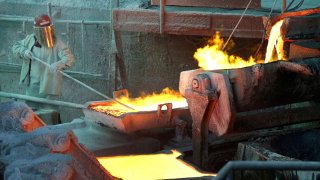
- Copper is headed for a price spurt over the next two years, as mining supply disruptions coincide with higher demand for the metal.
- Rising demand driven by the green energy transition and a decline in the U.S. dollar strength come the second half of 2024 will fuel support for copper prices.
- Copper prices on the London Metal Exchange last saw an all-time record high of $10,730 per ton in March last year.

Copper prices are set to soar more than 75% over the next two years amid mining supply disruptions and higher demand for the metal, fueled by the push for renewable energy.
Rising demand driven by the green energy transition and a likely decline in the U.S. dollar in the second half of 2024 will push copper prices higher, according to a report by BMI, a Fitch Solutions research unit.
Get New England news, weather forecasts and entertainment stories to your inbox. Sign up for NECN newsletters.
Markets are banking on the U.S. Federal Reserve to cut rates this year which will weaken the dollar and in turn make the greenback-priced copper more attractive to foreign buyers.
"The positive view for copper is more on macro factors," Bank of America Securities' head of Asia -Pacific basic materials, Matty Zhao, told CNBC, citing likely Fed rate cuts and a weaker U.S. dollar.
Additionally, at the recent COP28 climate change conference, more than 60 countries backed a plan to triple global renewable energy capacity by 2030, a move that Citibank says "would be extremely bullish for copper."
Money Report
In a December report, the investment bank forecast that the higher renewable energy targets would boost copper demand by extra 4.2 million tons by 2030.
This would potentially push copper prices to $15,000 a ton in 2025, the report added, way higher than the record peak of $10,730 per ton scaled in March last year.
"This assumes a very soft landing in the U.S. and Europe, an earlier global growth recovery, significant China easing," Citi analysts said, while also emphasizing on continued investments in the energy transition sector.
A growing economy tends to boost demand for copper, which is used in electrical equipment and industrial machinery. The metal's demand is considered a proxy for economic health.
Low supply, high demand
Copper on the London Metal Exchange was last trading at $8,559 a ton.
The base metal is a linchpin in the energy transition ecosystem, and is integral to manufacturing electric vehicles, power grids and wind turbines.
Other analysts see a bullish run for copper due to mining disruptions, with Goldman Sachs expecting a deficit of over half a million tons in 2024.
Last November, First Quantum Minerals halted production at the Cobre Panamá, one of the world's largest copper mines, following a Supreme Court ruling and nationwide protests over environmental concerns. Anglo American, a major producer, said it would cut copper output in 2024 and 2025 as it seeks to cut costs.
"The supply cuts reinforce our view that the copper market is entering a period of much clearer tightening," wrote Goldman's analysts, who see copper prices hitting $10,000 per ton within the year, and much higher in 2025.
The winners of the copper rush will be mainly Chile and Peru, BMI estimates. Both countries have large reserves of green transition minerals such as lithium and copper that are poised to benefit from increased investment and higher export demand. Chile holds around 21% of global copper reserves.
"Our confidence that copper substantially re-rates into 2025 [of $15,000 per ton average] is now substantially higher," Goldman said.
Lower supply also means that new copper smelters coming online will have a shortage of concentrates to work with, said S&P Global's Senior Copper Analyst Wang Ruilin.
Copper ores are extracted from the earth and then converted into copper concentrates. From there they are sent to smelters to be purified into refined copper, which sets the benchmark LME price.
"Copper smelters will see a supply shortage of concentrate starting in 2024, and the forecast deficits in the concentrate market is expected to deepen in 2025–27," she told CNBC via email.






